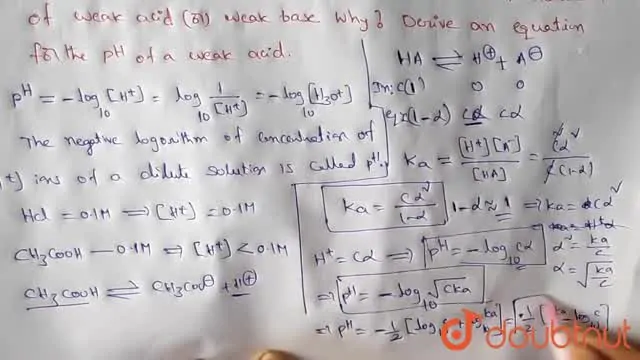Define pH. pH cannot be calculated directly from the molar concentration of a weak acid or weak base. Why? Derive an equation for the pH of a weak acid.Solution in Telugu
The pH of a solution is defined as the negative logarithim to base 20 of Hydrogen ion concentration (or)pH=log10[H+]
Strong acid and strong bases ionise completely in their aquous solutiosn. So the molar concentrations of strong acids or strong bases are equal to the molar concentrations of H+ and OH− ions produced by them.
Weak acids and weak bases do not ionise completely. So the molar concentrations of H+ ions or OH− ions produced by them are not equal to the molar concentrations of weak acids or bases from whcih they are produced. Hence pH of the aqueous solutions of weak acid and weak bases cannot be calculated from their molar concentrations.
pH of a weak acid:
Ionisation of weak acid
HX(aq)C(1−α)+H2O(l)⇔H3O+Cα(eq)+XCα(aq)
Applying law of mass action
Ka=[H3O+][X−][HX]Ka is acid dissociationn constant.
=Cα×CαC(1−α)
Since the weak acid α is very small as compared to 1, α in the denominator can be neglected. Then
Ka=Cα2. or α=√KaC
[H+]=C×α=C√KaC=√Ka×C
pH=−log[H+]=−log√Ka×C
∴pH=1/2PKa−1/2logC
Related Playlists
- BOOK - VGS PUBLICATION-BRILLIANTCHAPTER - CHEMICAL EQUILIBRIUM AND ACIDS-BASESEXERCISE - LONG ANSWER QUESTIONS16videos
CHEMICAL EQUILIBRIUM AND ACIDS-BASES
- BOOK - VGS PUBLICATION-BRILLIANTCHAPTER - CHEMICAL EQUILIBRIUM AND ACIDS-BASESEXERCISE - NUMERICAL PROBLEMS71videos
CHEMICAL EQUILIBRIUM AND ACIDS-BASES
- BOOK - VGS PUBLICATION-BRILLIANTCHAPTER - CHEMICAL EQUILIBRIUM AND ACIDS-BASESEXERCISE - ADDITIONAL QUESTIONS & ANSWERS8videos
CHEMICAL EQUILIBRIUM AND ACIDS-BASES
- BOOK - VGS PUBLICATION-BRILLIANTCHAPTER - CHEMICAL BONDING AND MOLECULAR STRUCTUREEXERCISE - LONG ANSWER QUESTIONS9videos
CHEMICAL BONDING AND MOLECULAR STRUCTURE
- BOOK - VGS PUBLICATION-BRILLIANTCHAPTER - CLASSIFICATION OF ELEMENTS AND PERIODICITY IN PROPERTIES EXERCISE - Long Answer Questions24videos
CLASSIFICATION OF ELEMENTS AND PERIODICITY IN PROPERTIES
Similar Questions
What are equilibrium processes? Explain equilibrium in Physical and Chemical processes with examples.
05:41View SolutionMole of PCl5 is heated in a closed vessel of 1 litre capacity. At equilibrium 0.4 moles of chlorine is found. Calculate the equilibrium constant.
07:26View SolutionPCl5,PCl3 and Cl2 are at equilibrium at 500K and having concentration 1.59MPCl3,1.59MCL2 and 1.41MPCl5. Calculate Kc for the reaction PCl5⇔PCl3+Cl2
52:45View SolutionExplain the formation of Ionic Bond with a suitable example.
01:10:23View SolutionDiscuss in detail about the classification of elements by Mendeleeff.
01:35View SolutionpH of weak Acid & Base. Brief
03:30View SolutionpH of a salt of a strong base with weak acid
01:46:20View SolutionEstimation of pH OF Weak Acid-Weak Base
01:16:31View SolutionQuestions based on Estimation of pH OF Weak Acid-Weak Base
View SolutionpH of a solution of salt of weak acid and weak base is : pH=1/2pK_w+1/2pK_a-1/2pK_b and that of weak acid and strong base is pH=1/2pK_w+1/2pK_a+1/2logc For a salt of weak acid and weak base having K_a=K_b , the pH at 25^@C will be
01:45View SolutionpH ను నిర్వచించండి. బలహీన ఆమ్లం, బలహీన క్షారం వీటి మోలార్ గాఢతల నుంచి pH ను లెక్కించలేం. ఎందువల్ల ?బలహీన ఆమ్లం pH కు సమీకరణం ఉత్పాదించండి.
32:16View SolutionTypes of electrolyte | pH calculation of strong acid and base | Mixture of strong acids and bases | Weak acid and weak base
01:08:02View SolutionpH Calculation of mixture of weak acids, bases, diprotic and triprotic weak acids | pH calculation of amphiprotic salts
01:00:58View SolutionWrite equation for calculate of pH of weak acid and weak base salt solution.
01:03:30View SolutionThe relation for calculating ph of a weak base is :
47:57View Solution


